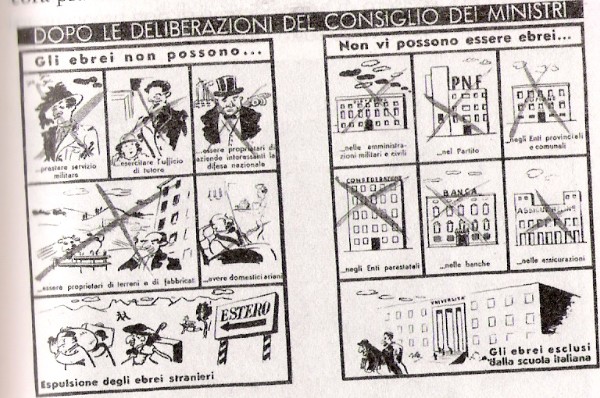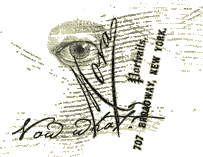Navigation
IntroductionFascism and the Jews
Anti-Semitic Laws
Mussolini and the Jews
Italian Culture
Cultural Myths of the Jews
Biological Racism
Terms
Conclusion
Sources
Recommended Reading


Anti-Semitic Laws
Despite vehemently denying that Italy would ever develop anti-Semitism,1 Mussolini did pass anti-Semitic laws. While most occurred 1938 and after, there was one law that predated the shift in legislation. In 1929, Mussolini agreed to a Concordat with the Vatican, which made Roman Catholicism the state religion of Italy.2 The impact of this was mainly upon education, as all the state schools then taught Catholicism. However, the Jewish community created their own schools, which helped form a new Jewish identity.3
In 1938, the Grand Fascist Council decreed the "Declaration on Race".4 The declaration introduced the idea of discriminzione, wherein Jews of certain merits could be exempt from some of the limitations of the law. However, the law did not exempt very much.5 Jews were no longer allowed to teach in schools, work in the military, work in public employment, be in the National Fascist Party, work in banks, and other such jobs.6 By disallowing Jews from the Fascist Party, the government could break the idea that Jews were Italian, because a true Italian was a Fascist. The only employment really left for Jews was self-employment or private employment.
Later that year, the government banned foreign Jews from entering the country; furthermore, any foreign Jew who became a resident of the country after 1918 was to be expelled in six months.7 Many foreign Jews had fled to Italy from Germany and other parts of Europe, and they entered Italy despite harsh border controls,8 so the government wanted to expel non-Italian Jews especially. Jews and Aryans could no longer intermarry.9
All of these laws aimed for one thing: the elimination of Jews from Italy. Instead of systematically killing Jews, the Italian government attempted to make them leave voluntarily through taking away rights.10 Due to the lack of employment opportunities, Jews had to search for new, generally low-paying jobs. Even working more than one job, the Jewish families fell into poverty.11 Many families did emigrate over seas due to the hardship imposed upon them by the new laws.12
By 1940, Italy had entered World War II allied with the Axis powers. The government decreed that all foreign Jews were to be interned in small camps, villages, and/or towns.13 The internment decree, however, also included a provision that said the Jews should be treated humanly and without violence, and this was actually followed.14 However, from 1940 to 1943, forced labor and internment camps became more common, and Italian as well as non-Italian Jews were herded to them.15

A Cartoon of the Restrictive Laws upon the Jews (Click to Enlarge)
Source: La difesa della razza: antologia 1938-1943 by Valentina Pisanty, page 33
By forcing the Jews into poverty, pushing them to emigrate, and interning the rest of the population, the Italian government managed to severely damage the Jewish Italian population. Many Jews experienced collective guilt feelings because they supported Fascism and Mussolini with fervor in the early years.16 Many Jewish and non-Jewish Italians also believed these laws to be a temporary byproduct of the alliance with Germany and the Axis powers.17 Further, the Italian Jews rejected the motivation of the laws; instead, some blamed other reasons for their limitations.18 This was most likely due to the fact that many still believed the party lines had not officially changed except to appease the Axis powers.
Despite these laws, Mussolini's attempts to promote anti-Semitism were resisted by the Italians.19 Many lower-level government officials helped behind the scenes, which enabled the Jews to survive.
Footnotes
- Fabre 62
- Roth 511
- Roth 511
- Levi 72
- Levi 72
- Levi 72
- Levi 76
- Roth 517
- Levi 76
- Levi 76
- Nidam-Orvieto 161
- Stille 20
- Levi 76
- Voigt 148
- Levi 76
- Nidam-Orvieto 158
- Nidam-Orvieto 167
- Caracciolo xvi
- Bookbinder 102
For more information on these footnotes, please see the sources.

© Kylie McCormick, Mount Holyoke College 2008.
